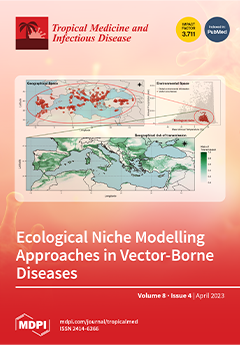Considering the ecological diversity of
E. coli, the main aim of this study was to determine the prevalence, phylogroup diversity, and antimicrobial susceptibility of
E. coli isolated from 383 different clinical and environmental sources. In total, varied prevalence was observed of the
[...] Read more.
Considering the ecological diversity of
E. coli, the main aim of this study was to determine the prevalence, phylogroup diversity, and antimicrobial susceptibility of
E. coli isolated from 383 different clinical and environmental sources. In total, varied prevalence was observed of the 197 confirmed
E. coli that were isolated (human–100%, animal–67.5%, prawn–49.23%, soil–30.58%, and water–27.88%). Of these isolates, 70 (36%) were multidrug-resistant (MDR). MDR
E. coli was significantly associated with their sources (χ
2 = 29.853,
p = 0.001). Humans (51.67%) and animals (51.85%) carried more MDR
E. coli than other environments. The
eae gene indicative of recent fecal contamination was not detected in any isolate, indicating that these
E. coli isolates could be present in these environments for a long time and became naturalized. Phylogroup B1 (48.22%) was the predominant group, being present in all hosts analyzed and with the commensal
E. coli group A (26.9%) representing the second predominant group. According to chi-square analysis, phylogroup B1 was significantly associated with
E. coli from humans (
p = 0.024), soil (
p < 0.001) and prawn samples (
p < 0.001). Human samples were significantly associated with phylogroup B1 (
p = 0.024), D (
p < 0.001), and F (
p = 0.016) of
E. coli strains, whereas phylogroup A (
p < 0.001), C (
p < 0.001), and E (
p = 0.015) were associated with animal samples. Correspondence analysis results also indicated the association of these phylogroups with their hosts/sources. The findings of this study exhibited a non-random distribution of phylogenetic groups, though the diversity index was highest for human
E. coli phylogroups.
Full article






